Wildlife spotting in U.S. national parks
Looking for the best wildlife viewing spots in America’s national parks? You’re in for a treat! The U.S. national park system offers some of the most incredible opportunities to witness animals in their natural habitats. From bears and wolves to rare birds and marine creatures, these protected areas showcase America’s rich biodiversity.

Yellowstone stands as the premier destination for wildlife enthusiasts, being the first national park established not only for its geothermal features but also for its remarkable array of animals. The park’s vast landscapes provide ideal viewing conditions for bison herds, wolf packs, and grizzly bears. But Yellowstone isn’t the only wildlife hotspot worth visiting. Wildlife spotting in U.S. national parks can be fun to see
Great Smoky Mountains National Park boasts impressive biodiversity with over 620 animal species and 2,278 plant varieties, making it America’s most biodiverse park. Meanwhile, Rocky Mountain National Park offers excellent wildlife spotting along its 48-mile Trail Ridge Road, where visitors can observe numerous species while driving across the Continental Divide.
Key Takeaways
Wildlife spotting in U.S. national parks
U.S. National Parks Offer Protected Wildlife Viewing – These parks serve as safe havens for diverse wildlife, allowing visitors to experience animals in their natural habitats without disturbing ecosystems.
Yellowstone and Great Smoky Mountains Have Unmatched Biodiversity – These two parks lead in species diversity, increasing the chances of encountering a variety of animals, from large mammals to rare bird species.
Each Park Offers Unique Wildlife Experiences – While Yellowstone is famous for large mammals like bison and bears, Rocky Mountain National Park is a paradise for bird watchers, and Everglades National Park is home to rare reptiles and wading birds.
Wildlife Activity Varies by Season – Spring and fall are typically the best times to observe active wildlife, as animals migrate, give birth, or prepare for winter.
Respectful Viewing Enhances Both Safety and Experience – Keeping a safe distance, using binoculars or telephoto lenses, and following park guidelines ensure a responsible and enjoyable wildlife experience.
Some Parks Feature Guided Wildlife Tours – Parks like Denali and Yellowstone offer ranger-led programs or safari-style tours, increasing the chances of spotting elusive animals while learning from experts.
Ecosystems Play a Key Role in Animal Sightings – Parks with diverse landscapes, such as wetlands, forests, and mountains, support a wider range of species and provide multiple viewing opportunities.
Conservation Efforts Help Sustain Wildlife Populations – National parks actively protect endangered species and restore habitats, ensuring that future generations can continue to witness these incredible animals in the wild.
The Allure of Yellowstone National Park
Yellowstone stands as America’s first national park, famous for both its geysers and incredible wildlife viewing opportunities. Nearly 300 bird species, 16 fish species, and numerous mammals call this pristine wilderness home.
Grizzly and Black Bears
When I visit Yellowstone, bear sightings top my wildlife wishlist. Both grizzly and black bears roam the park’s diverse habitats. The best times to spot these magnificent creatures are during early morning and evening hours when they actively feed.
Grizzlies are larger and have a distinctive shoulder hump with dish-shaped faces. Black bears, despite their name, can be brown or cinnamon colored. They’re more commonly seen in forested areas.
For safe viewing, I always maintain at least 100 yards distance from bears. Popular bear-watching locations include Lamar Valley and Hayden Valley, especially in spring when bears emerge from hibernation and forage in meadows.
Wildlife spotting in U.S. national parks
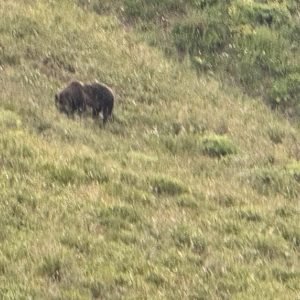

Wolves and Elk
Yellowstone’s wolf reintroduction program stands as one of America’s greatest conservation success stories. After being absent for decades, wolves once again roam the park’s wilderness.
The Lamar Valley, often called “America’s Serengeti,” offers the best wolf-watching opportunities. I bring binoculars or a spotting scope since wolves typically stay far from roads. Dawn and dusk provide optimal viewing chances.
Elk are much more numerous and easier to spot. These majestic animals gather in large herds, particularly during fall rutting season when bull elk bugle across meadows. Mammoth Hot Springs area frequently hosts elk that seem surprisingly comfortable around humans, though I always maintain a safe distance.
Bison and Pronghorns
Bison represent Yellowstone’s most iconic wildlife. These massive animals, weighing up to 2,000 pounds, roam freely throughout the park. “Bison jams” happen when these creatures decide to use the road as their path, creating memorable traffic delays.
I’ve spotted bison in most park areas, but Hayden Valley and Lamar Valley host the largest herds. Winter brings dramatic scenes of snow-covered bison using their massive heads to sweep away snow to reach buried grass.
Pronghorns, North America’s fastest land mammals, grace Yellowstone’s open grasslands. These tan and white animals can sprint at speeds over 50 mph. Their distinctive white rump patches flash as warning signals to others. The northern range between Mammoth and the Northeast Entrance offers excellent pronghorn viewing opportunities.
Wildlife spotting in U.S. national parks
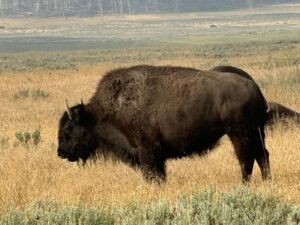
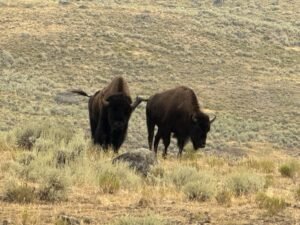
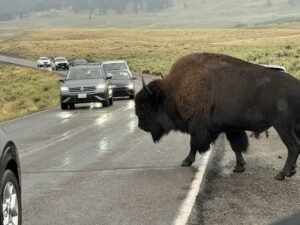
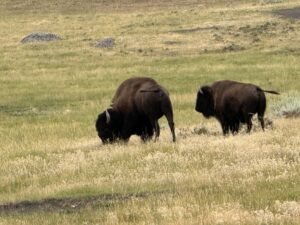
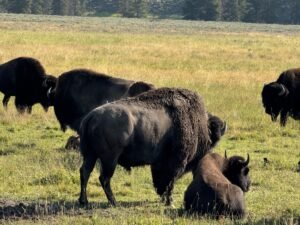
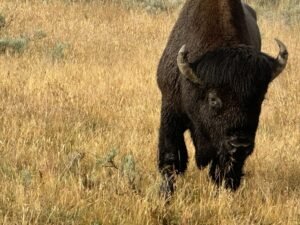
Unique Marine Life Encounters in Everglades National Park
The Everglades offers some of the most spectacular marine wildlife viewing in the United States. During my visits to this unique ecosystem, I’ve witnessed incredible interactions between various species in both freshwater and saltwater environments.
Alligators and Manatees
Alligators are the undisputed icons of the Everglades. These prehistoric-looking reptiles can be spotted year-round, often basking along waterways or silently gliding through the water. The best viewing spots include the Anhinga Trail and the freshwater sawgrass marsh boardwalks.
Unlike many national parks, the Everglades is home to both alligators and American crocodiles, though the latter are rarer and prefer saltwater areas.
Manatees represent another magical encounter in the park’s waterways. These gentle giants frequent the Ten Thousand Islands region during winter months. I’ve found early morning boat tours provide the best opportunity to see these endangered mammals feeding on seagrass.
For optimal manatee viewing, I recommend visiting between November and March when cooler temperatures drive them into warmer park waters.
Birdwatching Extravaganza
The Everglades hosts an astonishing variety of bird species, making it a paradise for birdwatchers. During migration seasons, the skies fill with colorful waders, raptors, and songbirds.
Some must-see species include:
- Roseate spoonbills with their distinctive pink plumage
- Great blue herons stalking fish in shallow waters
- Snowy egrets displaying their elegant white feathers
- Osprey diving dramatically for fish
The Flamingo district in the southernmost part of the park offers exceptional bird viewing opportunities. I’ve spent hours on the boardwalk trails watching wood storks, ibises, and occasionally the rare flamingo.
Dawn and dusk provide optimal lighting and activity for photography. Bring binoculars and a spotting scope for distant views across the sawgrass prairies where birds congregate in impressive numbers.
Glacier National Park: A Habitat for Diverse Species
Glacier National Park hosts an impressive array of predators that maintain the ecosystem’s balance. Grizzly and black bears roam throughout the park, with the best viewing opportunities in open meadows during spring and early summer.
Gray wolves have successfully returned to the park, though they remain elusive. I recommend scanning open valleys with binoculars at dawn for possible sightings.
Mountain lions and lynx inhabit the forest regions but are rarely seen due to their secretive nature. More commonly spotted predators include:
- Coyotes in open meadows
- Wolverines in remote backcountry areas
- Red foxes near forest edges
- Various raptor species soaring overhead
Rangers at visitor centers can provide updated information on recent wildlife activity and the safest viewing locations.
The Wonders of Acadia National Park
Acadia National Park offers some of the best wildlife viewing opportunities on the east coast. Located in Maine, this park combines mountains, forests, and coastline to create diverse habitats that support a wide variety of animal species.
Bird Species Galore
Acadia National Park is a paradise for bird watchers like myself. I’ve spotted numerous bald eagles soaring above Jordan Pond, their distinctive white heads visible against the blue sky. Cadillac Mountain provides excellent vantage points for watching hawks and falcons during migration seasons.
The park hosts over 300 bird species throughout the year. During spring and summer, I’ve observed colorful warblers flitting through the forests. Peregrine falcons nest on the park’s cliff faces, making a dramatic comeback after near extinction.
Shore birds are abundant along the rocky coastline. I recommend bringing binoculars to spot sandpipers, plovers, and gulls. Dawn and dusk offer the best viewing times when birds are most active.
Marine Wildlife Watching
The coastal areas of Acadia provide exceptional opportunities to observe marine wildlife. I’ve watched harbor seals lounging on offshore rocks during low tide. They’re particularly visible from the Ocean Path trail, where their dark bodies contrast against light-colored rocks.
Whale watching excursions depart from Bar Harbor. During summer months, I’ve seen humpback whales, minke whales, and occasionally the endangered right whale. Their massive forms breach the surface in spectacular displays.
Dolphins and porpoises often appear in the waters surrounding the park. Look for their dorsal fins cutting through the waves near Schoodic Peninsula. Tide pools reveal smaller marine life including starfish, crabs, and sea urchins.
For the best marine wildlife viewing, I suggest visiting during morning hours when waters are typically calmer.
Great Smoky Mountains: A Haven for Black Bears
The Great Smoky Mountains National Park hosts approximately 1,900 black bears throughout its diverse elevations. This remarkable density makes it one of the best places in the United States to observe these magnificent creatures in their natural habitat.
Elk Populations
Elk have made a successful comeback in the Great Smoky Mountains after being reintroduced in 2001. The best viewing location is Cataloochee Valley, particularly during early morning or late evening hours when they’re most active.
The herd has grown from an initial 25 animals to over 200 individuals today. Bulls can weigh up to 700 pounds, with impressive antlers that can span 5 feet.
I’ve found that spring and fall offer prime viewing opportunities. In September and October, the dramatic rutting season features bugling calls and competitive displays among males.
Unlike bears that roam throughout the park, elk primarily stay in open valley areas where they can graze on grasses and low-growing plants.
Salamander Diversity
The Great Smoky Mountains earned the nickname “Salamander Capital of the World” due to its extraordinary diversity of these amphibians. Over 30 salamander species call the park home, making it a global biodiversity hotspot.
I recommend exploring moist, shaded creekside trails like those near Kephart Prong or Deep Creek to spot these fascinating creatures. The park’s abundant rainfall and ancient forest ecosystems create perfect conditions for salamanders.
The red-cheeked salamander and black-bellied salamander are endemic species found nowhere else on Earth. Many salamanders in the park are lungless, breathing entirely through their moist skin.
During spring breeding season, you’ll find colorful salamanders gathering near water sources. Bring a small flashlight to peek under rocks and logs, but always replace habitat exactly as you found it.
Adventures in Denali National Park
Denali National Park offers some of the best wildlife viewing in the United States. The vast tundra landscape and diverse habitats provide excellent opportunities to spot iconic Alaskan mammals in their natural environment.
Spotting Caribou
Caribou are among the most fascinating creatures to observe in Denali. I’ve found that these animals often travel in small groups across the open tundra, making them relatively easy to spot from the park road.
The best time for caribou sightings is during the summer months when they migrate through the park. Many visitors report successful viewings from bus tours, which stop at known wildlife hotspots along the Denali Park Road.
Caribou have distinctive antlers that both males and females grow. Their light brown coats stand out against the green summer landscape. I recommend bringing binoculars since caribou may be visible at a distance across the rolling tundra.
For the highest chances of success, focus your attention on open areas early in the morning or late in the evening when wildlife is most active.
Dall Sheep and Moose Observations
Dall sheep are distinctive with their bright white coats and curved horns. They prefer rocky slopes and mountainous terrain where they can escape predators.
The best places for Dall sheep sightings include higher elevation areas along the park road. I’ve had luck spotting them using spotting scopes at locations like Polychrome Pass and Eielson Visitor Center.
Moose, in contrast, tend to inhabit lowland areas with willow thickets and ponds. These massive mammals are often spotted near water sources or in wooded areas along the first 15 miles of the park road.
Bull moose grow impressive antlers that can span up to 6 feet wide. Cow moose are sometimes accompanied by calves, especially in spring and early summer. When viewing moose, I always maintain a safe distance as they can be unpredictable and potentially dangerous when startled.
Rocky Mountain National Park: A Birder's Paradise
Rocky Mountain National Park offers incredible wildlife viewing opportunities with over 280 bird species and 60 mammal species calling it home. The diverse mountain habitats create perfect conditions for spotting unique wildlife throughout the seasons.
Wildlife Along the Hiking Trails
When I hike the trails of Rocky Mountain National Park, I’m always amazed by the variety of birds I encounter. The elusive white-tailed ptarmigan is one of the most sought-after birds in the park. Though common, these birds blend perfectly with their surroundings, making them challenging to spot.
The alpine and subalpine zones host unique bird species adapted to high elevation living. I’ve spotted mountain chickadees, Clark’s nutcrackers, and Steller’s jays during my hikes through the forests.
For the best bird watching, I recommend early morning visits to areas like Cub Lake Trail or the Wild Basin area. Bringing binoculars is essential, as many birds perch in tall pines or soar overhead along mountain ridges.
Majestic Elk Herds
The elk of Rocky Mountain National Park are truly a spectacular sight. During my visits, I’ve witnessed herds numbering in the hundreds, especially during the fall rutting season when bulls bugle across the valleys.
The best viewing spots include Moraine Park, Horseshoe Park, and Upper Beaver Meadows. Dawn and dusk offer prime viewing times when elk emerge from forested areas to graze in open meadows.
In fall, bull elk compete for females with impressive antler displays and haunting bugle calls that echo through the mountains. I always maintain a safe distance of at least 75 feet from these massive animals.
The park’s elk migration patterns follow seasonal changes, moving to higher elevations in summer and returning to valleys in winter, providing year-round viewing opportunities for park visitors.
Desert Wildlife in Saguaro National Park
Saguaro National Park offers incredible wildlife viewing opportunities in its unique desert ecosystem. Located near Tucson, Arizona, this park is home to diverse animal species that have adapted to the harsh desert conditions.
When I visited Saguaro, I regularly spotted roadrunners darting across trails. These fast-moving birds are a common sight along with hundreds of other bird species that inhabit or migrate through the park.
The park is also famous for its reptiles. Horned lizards and the venomous Gila monster can be seen basking in the sun during warmer months. These distinctive reptiles are well-adapted to desert life.
Mammals are abundant too. Javelinas (collared peccaries), which resemble wild pigs but are actually unrelated, roam in small groups. They’re about the size of medium dogs and are frequently spotted by visitors.
Other mammals you might encounter include:
- Kangaroo rats
- Jackrabbits
- Bobcats
- Mountain lions (rare sightings)
- Bats (especially active at dusk)
Looking for wildlife doesn’t always mean direct sightings. I often search for signs like:
- Nests in saguaro cacti
- Animal droppings on trails
- Burrows in the ground
- Scratching marks on trees and cacti
The park hosts volunteer fence removal projects during cooler months to improve wildlife connectivity and movement throughout the region.
For the best wildlife viewing, I recommend early morning or late afternoon visits when animals are most active and temperatures are cooler.
Virgin Islands National Park: Tropical Wildlife and Coral Reefs
Virgin Islands National Park covers two-thirds of St. John island and protects diverse marine habitats. The park’s crystal-clear waters shelter an incredible array of tropical wildlife within its protected coral reefs, seagrass beds, and mangroves.
Sea Turtles and Sea Birds
The turquoise waters of Virgin Islands National Park provide an ideal habitat for sea turtles. I’ve observed these gentle giants gliding gracefully through the water during my visits. Green sea turtles and hawksbill turtles are commonly spotted near seagrass beds and coral reefs.
The park isn’t just about marine life. Many seabirds call this tropical paradise home. Brown pelicans dive dramatically for fish, while frigatebirds soar overhead with their distinctive forked tails.
Mangrove forests along the shoreline serve as important nesting sites for birds and nurseries for young marine creatures. These areas are worth exploring by kayak for a quieter wildlife viewing experience away from busy snorkeling spots.
Snorkeling with Tropical Fish
Snorkeling is the best way to discover the vibrant underwater world of Virgin Islands National Park. The park’s protected coral reefs teem with colorful tropical fish and fascinating marine creatures.
Popular snorkeling spots include:
- Trunk Bay: Features an underwater trail with informative plaques
- Maho Bay: Calm waters perfect for beginners
- Waterlemon Cay: More advanced spot with diverse coral and fish species
I’ve seen parrotfish, angelfish, and blue tangs darting among the coral formations. The clarity of the water makes wildlife viewing exceptional even for first-time snorkelers.
The park offers guided snorkeling tours and glass-bottom boat trips for those who prefer to stay dry. The best snorkeling conditions typically occur in the morning when waters are calmest and visibility is highest.
Big Bend National Park: A Hidden Gem for Desert Wildlife
Tucked away in far West Texas, Big Bend National Park offers some of the most diverse wildlife viewing opportunities I’ve encountered. The park’s varied habitats support an impressive array of animals that have adapted to life in this rugged landscape.
With over 11 species of amphibians, 56 species of reptiles, and 40 species of fish, Big Bend is truly a biodiversity hotspot. I’ve found that early mornings and evenings provide the best chances to spot wildlife.
The collared peccary, commonly known as javelina, is one of the park’s most frequently encountered mammals. These pig-like creatures often travel in small family groups through the desert terrain.
Top Wildlife to Spot in Big Bend:
- Javelinas (collared peccaries)
- Roadrunners
- Desert bighorn sheep
- Mountain lions (rare)
- Various lizard species
- Black bears (in mountain areas)
The park’s mountains, deserts, and river habitats create multiple ecosystems within one protected area. This environmental diversity explains why so many different animals thrive here.
I recommend bringing binoculars and exploring some of the park’s 150+ miles of trails. The varied terrain provides different wildlife viewing opportunities depending on which habitat you’re exploring.
Remember to maintain a safe distance from all wildlife. These animals are wild and should be observed respectfully from afar.
Top Wildlife Spotting Opportunities in U.S. National Parks: Best Locations and Seasons for Animal Encounters
The United States is home to some of the world’s most diverse ecosystems, spread across its many national parks. Whether you’re hoping to spot a grizzly in Yellowstone, a moose in Denali, or a bald eagle in Everglades, each park offers unique opportunities to observe wildlife in their natural habitat. Timing is everything, as different seasons bring varying animal behaviors, migrations, and visibility.
1. Yellowstone National Park (Wyoming, Montana, Idaho)
Best Time for Wildlife Viewing: Spring (April–June) and Fall (September–October)
Top Animals to See: Grizzly bears, wolves, bison, elk, bald eagles
Yellowstone is a wildlife enthusiast’s dream, home to North America’s largest concentration of mammals. Spring is ideal for spotting newborn bison and elk calves, while fall is the best time for witnessing dramatic elk rutting behavior. Lamar Valley, often called “America’s Serengeti,” is the premier spot for wolves and grizzlies.
2. Denali National Park (Alaska)
Best Time for Wildlife Viewing: Summer (June–August)
Top Animals to See: Moose, caribou, Dall sheep, wolves, grizzly bears
Denali’s vast tundra and boreal forests provide incredible opportunities to see the “Big Five” – moose, caribou, Dall sheep, wolves, and grizzlies. The best way to explore is via the park’s bus tours, as private vehicles have limited access beyond Mile 15.
3. Everglades National Park (Florida)
Best Time for Wildlife Viewing: Winter (December–April)
Top Animals to See: American alligators, manatees, roseate spoonbills, dolphins
Winter is the best season for spotting wildlife in Everglades National Park as water levels drop, concentrating animals into smaller areas. Visit Shark Valley for alligators sunbathing along the trails or take a boat tour in the Ten Thousand Islands to see playful dolphins and endangered manatees.
4. Great Smoky Mountains National Park (Tennessee, North Carolina)
Best Time for Wildlife Viewing: Spring (April–June) and Fall (September–November)
Top Animals to See: Black bears, elk, white-tailed deer, salamanders
Home to one of the densest populations of black bears in the U.S., Great Smoky Mountains National Park offers excellent viewing, especially in Cades Cove and Roaring Fork. Fall is an exceptional time to see elk in Cataloochee Valley, while spring brings vibrant displays of salamanders—earning the park its title as the “Salamander Capital of the World.”
5. Glacier National Park (Montana)
Best Time for Wildlife Viewing: Summer (June–August)
Top Animals to See: Mountain goats, grizzly bears, moose, wolverines
Glacier’s rugged peaks and alpine meadows make it a prime destination for spotting mountain goats—often seen perched on rocky ledges along Logan Pass. Early mornings in Many Glacier offer a chance to see grizzlies and moose grazing near the lakes.
6. Olympic National Park (Washington)
Best Time for Wildlife Viewing: Spring (April–June) and Fall (September–October)
Top Animals to See: Roosevelt elk, black bears, river otters, orcas
From dense rainforests to coastal tidepools, Olympic National Park supports a variety of wildlife. The Hoh Rainforest is an excellent place to spot Roosevelt elk, while the coastal areas near Rialto Beach offer opportunities to see river otters and even migrating gray whales.
7. Grand Teton National Park (Wyoming)
Best Time for Wildlife Viewing: Fall (September–October) and Spring (May–June)
Top Animals to See: Moose, grizzly bears, pronghorn, bald eagles
Grand Teton’s diverse landscape provides a perfect habitat for large mammals. Willow Flats and Oxbow Bend are known for moose sightings, while bears can often be spotted in the northern regions of the park during early mornings or late evenings.
8. Rocky Mountain National Park (Colorado)
Best Time for Wildlife Viewing: Fall (September–October) and Summer (June–August)
Top Animals to See: Elk, bighorn sheep, mule deer, black bears
Fall is a spectacular time to witness elk bugling during the rut in Moraine Park and Horseshoe Park. Bighorn sheep can be seen navigating the high cliffs near Trail Ridge Road, while black bears are more commonly spotted in the lower forested regions.
9. Yosemite National Park (California)
Best Time for Wildlife Viewing: Spring (April–June) and Fall (September–November)
Top Animals to See: Black bears, bobcats, mule deer, Sierra Nevada bighorn sheep
Yosemite’s black bears are active throughout the park, particularly around the Yosemite Valley. Tuolumne Meadows provides excellent opportunities to see Sierra Nevada bighorn sheep in their alpine habitat.
10. Acadia National Park (Maine)
Best Time for Wildlife Viewing: Spring (April–June) and Fall (September–October)
Top Animals to See: Peregrine falcons, white-tailed deer, harbor seals, moose
Acadia’s rocky coastline and lush forests provide a habitat for a variety of species. Jordan Pond is a great place to see white-tailed deer, while the cliffs of Precipice Trail offer sightings of peregrine falcons. Boat tours can take visitors out to see harbor seals lounging on coastal rocks.
Wildlife Viewing Tips
- Go Early or Late: Dawn and dusk are the best times for animal activity.
- Use Binoculars: Keep a safe distance to avoid disturbing wildlife.
- Stay Quiet and Patient: Many animals are elusive, and silence improves your chances of spotting them.
- Follow Park Guidelines: Respect all wildlife, maintain proper distances, and avoid feeding animals.
Frequently Asked Questions
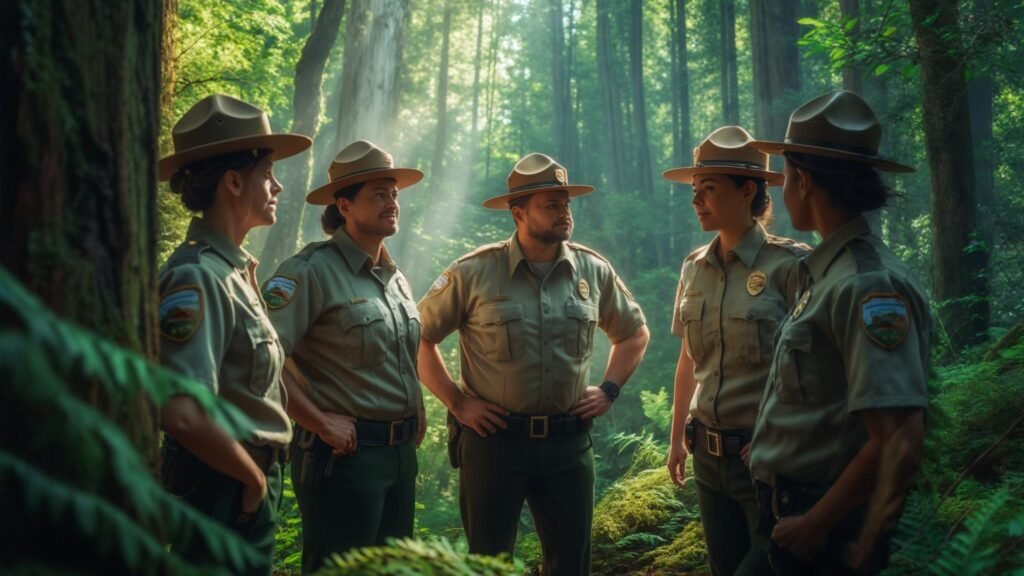
Visitors to national parks often have questions about wildlife viewing opportunities. These common questions address park choices, animal diversity, photography tips, and optimal viewing seasons to make your wildlife experience memorable.
Which U.S. National Parks offer the best wildlife watching experiences?
Yellowstone National Park stands out as the premier destination for wildlife enthusiasts. You’ll likely encounter bears, bison, elk, deer, moose, sheep, and mountain goats during your visit.
Biscayne National Park in Florida offers a different experience with over 1,000 species of wildlife, primarily marine creatures and birds.
Grand Teton National Park, adjacent to Yellowstone, provides excellent opportunities to view large mammals in spectacular mountain settings.
In which U.S. National Parks are you likely to encounter a diverse range of animal species?
Yellowstone tops the list for land mammal diversity, with opportunities to see predators and prey species interacting in their natural habitat.
Biscayne National Park offers remarkable marine diversity, with countless fish species, sea turtles, manatees, and dolphins.
Carlsbad Caverns National Park is known for its bird diversity, including the spectacular bat flights that occur at dusk during warmer months.
What are some top-rated locations for wildlife photography within U.S. National Parks?
Lamar Valley in Yellowstone is often called “America’s Serengeti” for its open vistas and abundant wildlife, making it perfect for photographers.
The meadows of Grand Teton provide stunning foreground subjects (animals) with the dramatic Teton mountain range as a backdrop.
Coastal areas of Olympic National Park offer opportunities to photograph tide pool creatures, eagles, and occasionally marine mammals against scenic shorelines.
How can one maximize their chances of witnessing unique wildlife in U.S. National Parks?
Visit during early morning or evening hours when animals are most active. Many species rest during the heat of the day and become more visible at dawn and dusk.
Maintain a respectful distance of at least 25 yards from most wildlife and 100 yards from predators like bears and wolves. Using binoculars or a spotting scope enhances viewing without disturbing animals.
Research seasonal animal movements before your trip. Rangers can provide updated information about recent wildlife sightings when you arrive.
Which U.S. National Parks are known for specific animal encounters?
Katmai National Park in Alaska offers unparalleled brown bear viewing, especially during salmon runs.
Channel Islands National Park provides opportunities to see unique island fox species found nowhere else on earth.
Theodore Roosevelt National Park in North Dakota features some of the best wild horse viewing in the country.
Isle Royale National Park presents the chance to learn about the famous wolf and moose predator-prey relationship that has been studied for decades.
What times of the year are ideal for wildlife spotting in U.S. National Parks?
Spring (April-June) offers excellent viewing as animals become more active after winter, and new offspring appear. Baby animals are abundant, though weather can be unpredictable.
Fall (September-October) coincides with breeding seasons for many species like elk, with spectacular displays of behavior and competitions between males.
Winter provides unique opportunities to see animals against snow backgrounds, with fewer crowds competing for viewing spots. Some parks offer specialized winter wildlife tours.
My Final Thoughts
Visiting U.S. National Parks for wildlife spotting has been one of my most rewarding travel experiences. Each park offers unique encounters with animals in their natural habitats.
Yellowstone stands out as the premier destination, where I’ve consistently spotted bears, bison, elk, and moose during my visits. The diversity of wildlife in one location is truly unmatched.
The Everglades surprised me with its abundance of species. Walking along the trails and mangroves, I encountered alligators, various bird species, and even the occasional manatee in the waterways.
I found that timing matters significantly. Dawn and dusk provide the best viewing opportunities when animals are most active. Visiting during shoulder seasons (spring and fall) also means fewer crowds and more wildlife sightings.
My top tips for wildlife viewing:
- Bring quality binoculars
- Speak quietly and move slowly
- Keep a safe distance from all animals
- Visit ranger stations for recent sighting information
- Pack patience – wildlife viewing requires time
Remember to respect park rules about wildlife interactions. The 100-yard distance from predators like bears and wolves, and 25 yards from other wildlife exists for both your safety and theirs.
I believe these parks offer not just beautiful landscapes but important connections to nature that remind us why conservation matters.




























